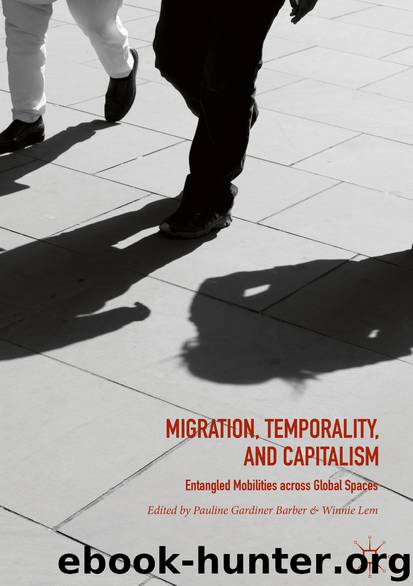Migration, Temporality, and Capitalism by Pauline Gardiner Barber & Winnie Lem

Author:Pauline Gardiner Barber & Winnie Lem
Language: eng
Format: epub
Publisher: Springer International Publishing, Cham
The Sociality of Time
Emile Durkheim’s studies of religion and religious life were foundational to the conceptualization of time in the social sciences (Gell 1996 [1992]). Durkheim emphasized time when he argued that ideas of time “dominate all intellectual thought”, perceptions of time being “the solid frame which encloses all thought” (Durkheim 2008 [1915]: 9). Giving the example of the way we, as human beings, divide time into days, weeks, months and years, Durkheim argued that these divisions are the products of collective and social events in society such as rites and public ceremonies. Thus, the use of a calendar illustrates how time is shaped by society, while simultaneously being integral to society’s regulation (Durkheim 2008: 10–11). According to Durkheim , we cannot think of time without dividing it into bits and pieces. In line with Durkheim’s suggestion that time is universal, social and collective, classic anthropologists like E.E. Evans-Pritchard (1969) in his study of the Nuer proposed that time can take two forms: “oecological time” and “structural time”. Time, as an ecological rhythm, is organized in years that are divided into a cycle following the ecological rhythm of rain and drought (Evans-Pritchard 1969: 93). Structural time, on the other hand, takes place within the context of the social structure through which people relate to each other, thus enabling “a reflection of relations between linages … a looking backwards, since relationships must be explained in terms of the past” (1969: 108).
Evans-Pritchard’s (1969) definition of the experience of time among the Nuer can be criticized for being static and unchangeable (Whyte 2009: 238). Both Durkheim and Evans -Pritchard nevertheless made important contributions by pointing out that time is experienced as embedded within a particular context; in other words, it is a form of sociality. Newer anthropological work builds on the conceptualization of time as relational . Mains (2007: 667), for one , argues that “time is taken as a measure of human activity, but it is used to measure and quantify relationships rather than labor and its corresponding monetary value”. The close association between time and sociality, I argue, is key to understanding Somali migration. As I illuminate throughout this chapter, it was the experience of time within the context of being young persons, neither children nor adults ( cf. Mains 2007), that made my interlocutors migrate, for example, of not being considered a mature man able to make important decisions within the family or the clan, not being able to finance a good education, find a job, get married, provide for the family who had cared for them since their childhood, etc.1 In other words, it was the inability to live up to both their own hopes as well as the surrounding community’s expectations for their present and future time that led to the decision to migrate. In moving on from Somaliland, time continued to be experienced through the contingency of various others, understood not only as human beings, but as family , friends, brokers, strangers, their own health or the environment—or, to use Evans-Pritchard’s (1969) term (and spelling) ‘oecological time’.
Download
This site does not store any files on its server. We only index and link to content provided by other sites. Please contact the content providers to delete copyright contents if any and email us, we'll remove relevant links or contents immediately.
International Integration of the Brazilian Economy by Elias C. Grivoyannis(98887)
The Radium Girls by Kate Moore(11971)
Turbulence by E. J. Noyes(7977)
Nudge - Improving Decisions about Health, Wealth, and Happiness by Thaler Sunstein(7656)
The Black Swan by Nassim Nicholas Taleb(7056)
Rich Dad Poor Dad by Robert T. Kiyosaki(6513)
Pioneering Portfolio Management by David F. Swensen(6256)
Man-made Catastrophes and Risk Information Concealment by Dmitry Chernov & Didier Sornette(5956)
Zero to One by Peter Thiel(5732)
Secrecy World by Jake Bernstein(4700)
Millionaire: The Philanderer, Gambler, and Duelist Who Invented Modern Finance by Janet Gleeson(4421)
The Age of Surveillance Capitalism by Shoshana Zuboff(4245)
Skin in the Game by Nassim Nicholas Taleb(4202)
Bullshit Jobs by David Graeber(4139)
The Money Culture by Michael Lewis(4133)
Skin in the Game: Hidden Asymmetries in Daily Life by Nassim Nicholas Taleb(3961)
The Dhandho Investor by Mohnish Pabrai(3722)
The Wisdom of Finance by Mihir Desai(3693)
Blockchain Basics by Daniel Drescher(3540)
